When the Oculus Rift VR headset came out earlier this year, it was promising but incomplete. It had this nice, comfy set of virtual reality goggles… but that was all. This week, Oculus finally catches up.
Competitors like the Valve-backed HTC Vive and to a lesser extent Sony’s PlayStation VR have already demonstrated why handheld motion-controls are an essential component of modern VR. Motion controllers allow your hands to appear as independently controlled weapons, wands or even just hands in virtual reality, which allows for a hugely expanded number of possible physical interactions.
With a standard controller, most VR games either make you a floating camera looking down on an otherwise ordinary game or sit you in the cockpit of a vehicle. With motion controls, you can be there in a more involved way.
Oculus has been prototyping and demoing the Touch controllers for ages now, but I actually hadn’t tried them until they sent me a pair in mid-November. I’ve now used them to play a ton of VR games both through Oculus’ Home software and on Steam.
I’ve been impressed with the controllers overall. They combine with the Rift headset to make Oculus’ VR system the most technically impressive and pleasant to use of any virtual reality hardware currently on sale. They also have the broadest collection of supported games and applications with the highest average bar of quality. If you already own a Rift, I’d be hard-pressed not to recommend you drop another couple hundred bucks on a set.
The Basics
The Touch controllers come with a second sensor camera to accompany the one that came with the Rift. Two sensors are required to use the controllers. The controllers and their sensor cost $US199 ($266) on top of the Rift’s $US599 ($800) price tag, which brings the total cost up to around $US800 ($1,069).
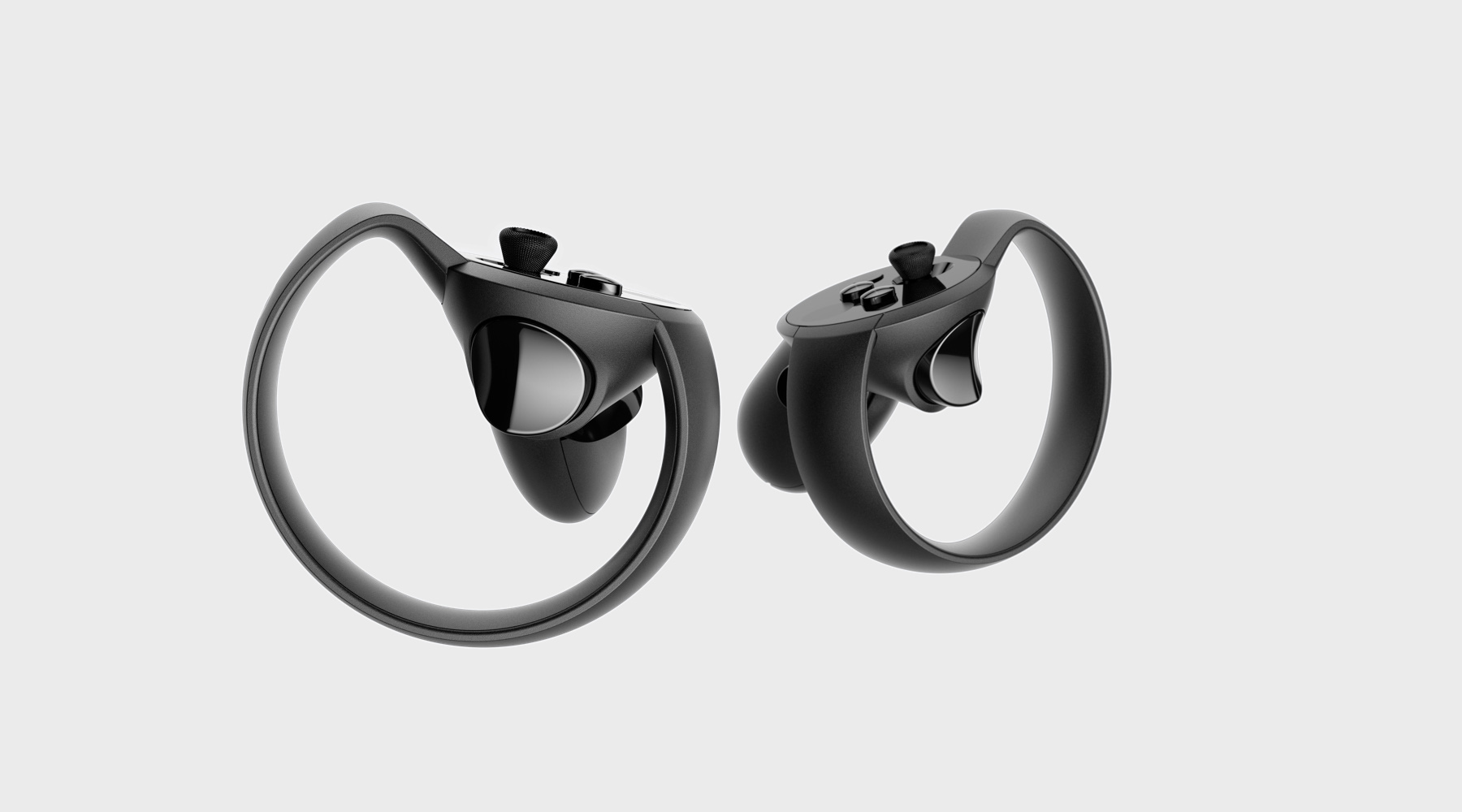
Official product shot
I have been mostly using the Touch controllers with an experimental three sensor setup that lets the cameras see around me in 360 degrees. With that set-up, my body never blocks the camera from seeing a controller. It’s a crucial component of doing full “room-scale” VR, given that I ran into some controller-blocking stutter when I played with two sensors.
I’ll talk more about the sensor setup in a bit, but the short version is: if you have the means, I recommend going with a three-sensor setup. Sensors cost $US80 ($107) on their own, so a full three-sensor Oculus Touch setup will run you $US880 ($1,176) along with the cost of any USB extension cables you may need.
The VR Experience
Big picture: these are good motion controllers that match or exceed the similar HTC Vive controllers in just about every respect. (They also out-perform the PSVR’s archaic Move controllers, though that almost feels like an unfair comparison.) The vast difference between headset-only VR and motion-controlled VR is immediately apparent. The Touch controllers will finally let Oculus users experience the best of what current virtual reality has to offer.
I’ve played a lot of room-scale games on the Vive, and playing them on the Rift (with a three-sensor setup) feels essentially identical. The primary difference is that the Vive allows for a larger possible playspace, but I’ve gotten along fine with a 6′ x 6′ space that the Oculus setup tool describes as “optimal.”
I’ve generally found that games are best for short periods of time, though I can play a lot longer in room-scale than I can while sitting down and using a controller. The overall Touch experience is for the most part smooth, intuitive, and straightforward, though even the smoothest experience will occasionally be shaken up by weird tracking and hand-stutters.
The Touch controllers’ big new feature is that they have sensors on the thumbstick and buttons that detect when your fingers are touching them. If a game has been made to support this feature, it means you can pick up your thumb and make a thumbs-up in game, or point your index finger in real life and see a matching index point in-game. That adds a small but noticeable level of fine hand control and contributes to a nebulous sensation Oculus describes as “hand presence.”
For example, In Job Simulator on Touch, you can independently control your thumb, index finger, and hand grip, mostly without even pressing a button:
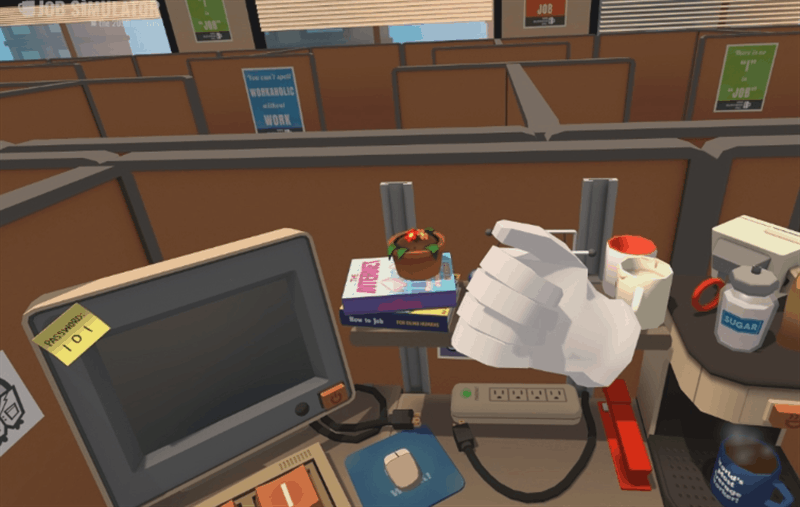
The pointer finger gives you a natural way to interact with the buttons and objects in the game-world, which leads to all sorts of sophisticated VR interactions:
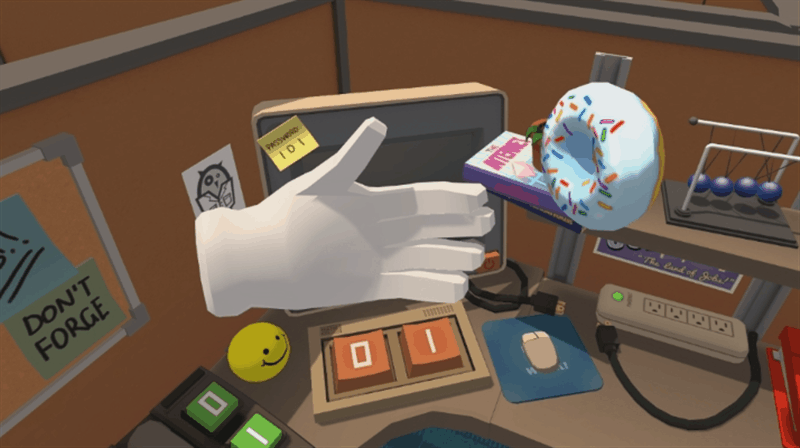
At their best, the Touch finger-sensors really do make it feel like your hand movements are being accurately reflected in the game. No option for a middle finger yet, sadly.
Setup is straightforward, but can come unstuck.
Touch setup is mostly seamless and straightforward, but a few small things about the process are kind of a pain. The Oculus app walks you through pairing your controllers with your PC, and before long you’ll be standing up in front of the sensors and tracing the boundaries of your protected playspace.
Once you’ve defined your space, Oculus’ “Guardian” system will project transparent walls in VR whenever you come close to leaving the boundaries. The system is effectively identical to Valve’s SteamVR chaperone, which, surprise, you’ll also have to set up if you plan on using the Rift to play Steam games.
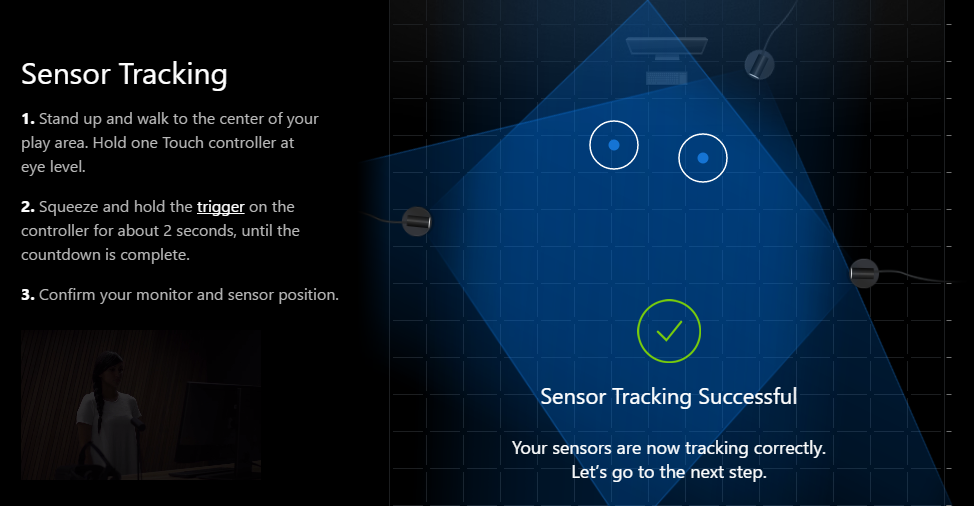
I set up my Rift with three sensors, which allows me to get 360-degree tracking and room-scale.
Because the Rift sensors sit on my desk like webcams, I sometimes bump or jostle them while moving things around. That’s usually not a problem, but at least once it caused my entire playspace to reorient itself and sink 3.05m into the floor. It was annoying, though I can’t really think of a good way around it short of mounting my cameras on the wall.
Two-sensor setup is much easier to pull off; when setting up three sensors, the setup app tends to tell me something is wrong with my sensor placement even when it’s worked fine in the past. It’s possible to set up two sensors to provide 360-degree tracking, though I haven’t experimented much with that option. Oculus carefully points out that 360-degree tracking is “experimental,” and given how essential full tracking is to many VR games, I hope Oculus gets things a bit smoother sooner rather than later. For now, it’s more than functional.
The controllers feel good to use.
The Touch controllers are smaller and sturdier than I expected. They fit into the palms of my hands and don’t extend much beyond them. It took me a few minutes to get used to picking them up and putting them down, but after that they became second nature. The buttons are springy and feel like they’re in the “right” places. The controllers enhance the appeal of interacting with VR in a hard-to-describe, tactile way.
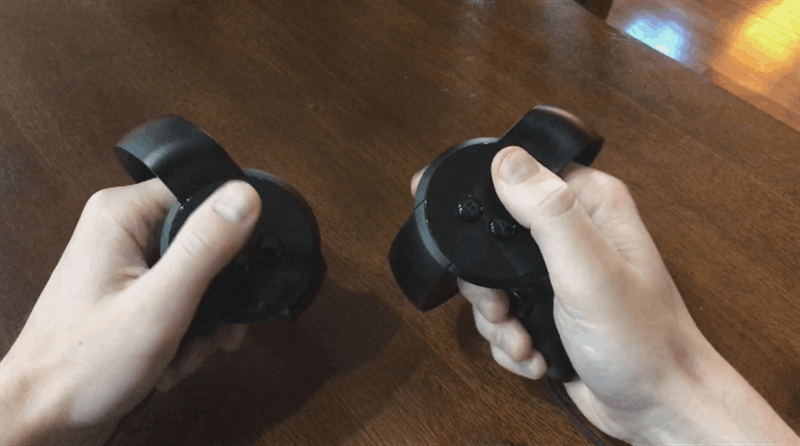
Each controller is designed with a ring-like counterbalance so that it sits comfortably in the palm of your hand. The counterbalance encircles your fingers and tilts the controller’s weight every so slightly backward, which lets it rest in the space between your thumb and index finger. They don’t come with a stand and are oddly difficult to store — I opt to place them triggers-down so that the balance ring holds them steady. I found myself using the included wrist-straps so that I could let them dangle off my wrists when I needed to do something else with my hands.
Oculus has removed a lot of barriers between me and VR.
When I imagine picking up the Touch controllers and putting on a Rift, I feel invited to do so. That’s often not been the case with VR this year — usually when I contemplate putting on a VR headset, I mentally gird myself for the setup process, the plugging in of the things, the shaking loose of the cables, the turning on of the controllers, the donning of the headphones, and so on.
My Rift is set up right next to my gaming PC, and I’ve already got enough clear space in my office for a functional playspace. I push my desk chair off to the side and my physical area is good to go. I put on the Rift and it automatically turns itself on. The built-in earphones are all ready to output game audio. Same thing goes for the controllers — I pick them up, press any button, and they’re instantly activated and working.
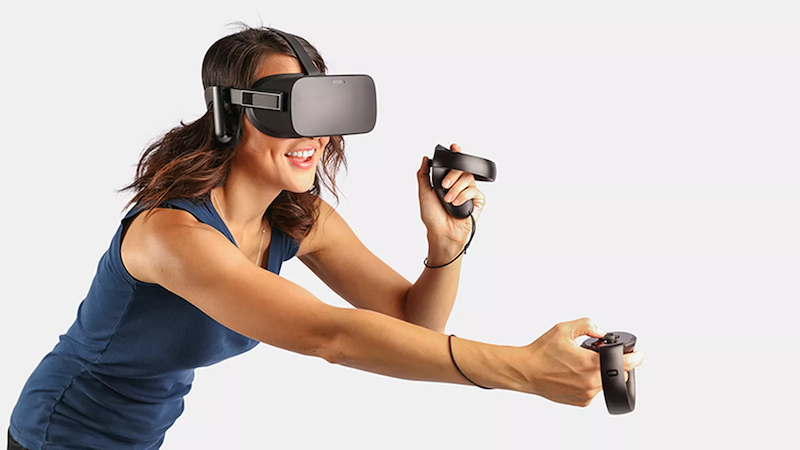
Above: A professional actor recreates my facial expression when I play good VR games.
The Touch controllers use a single AA battery each. Battery life has been impressive — they have managed to remain ready and alert for a few weeks without requiring a swap. I prefer Oculus’ use of replaceable batteries over a built-in battery pack because it means I don’t have to plug or unplug the controllers between uses. I just pick them up and boom, ready to go.
On the whole, Oculus has only removed two or three small things I have to do when prepping other VR headsets — and the Oculus store and interface still need work — but it’s remarkable how much of a difference that makes. Granted, I’ve got the benefit of a room that perfectly fits my playspace, though it is possible to play Rift games while standing still.
On a usability scale from iPad to nuclear submarine, VR is still generally more of a sub. Oculus’ slow but steady progress toward the tablet end of things demonstrates the company’s commitment to ease of use.
The Oculus store is getting a ton more games, and some are really fun.
On December 6 the Oculus store will get an injection of more than 50 new games, all of which are designed to be played with the Touch controllers. Some, like Fantastic Contraption, Job Simulator and Space Pirate Trainer, are SteamVR stalwarts that are making the jump over to a new platform. Others like Superhot VR, VR Sports Challenge and The Unspoken are brand-new Rift exclusives. (Some of those exclusives are temporary, others are permanent.) Still others like The Climb have been playable with a regular controller for some time but are being patched to support Touch.
In addition to the games on the Oculus store, the Rift works with an increasing number of VR games played directly through Steam. With access to both the Oculus store and SteamVR, the Oculus Rift library is significantly larger than it would have been had the Rift been constrained to the Oculus store. However you may feel about Oculus’ aggressive use of financing deals to lock down timed exclusivity (along with their own fully-funded platform exclusives), the results are undeniable: Oculus now has the strongest game library of any VR headset.
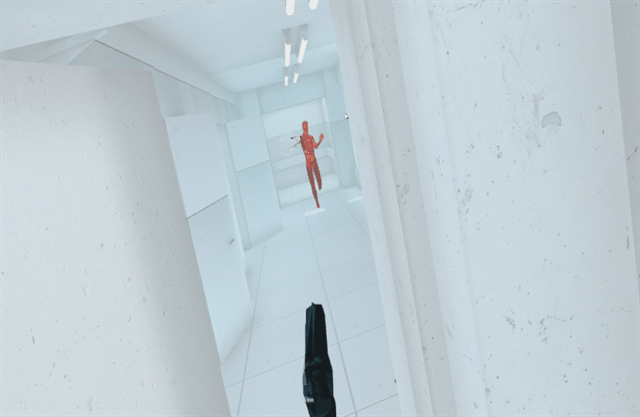
Above: Dodging the bullet in Superhot VR
I’ve played a lot Touch launch games over the last few weeks, and some are pretty damn good. Superhot VR takes the slow-mo combat that I loved in the base game and smoothly adapts it into a whole new series of VR-only encounters.
It effectively recreates the fantasy of engaging in your own slow-mo John Woo shootout. The Unspoken is another high-polish Oculus exclusive from Insomniac Games that casts you as a member of a modern-day underground wizarding community. You use the Touch controllers to lob fireballs and cast intricate curses and hexes while fighting against other players.
It’s too bad the game didn’t come with a more fleshed-out set of single player challenges, but still pretty cool to throw around magic in VR.
Schell Games’ I Expect You To Die is a charming James Bond riff that puts you in a variety of tricky situations and asks you to engineer your own escape. It’s a fairly standard environmental puzzle-solving game that takes on a new dimension in VR as you peer around your environment and attempt to brainstorm your way around a new set of deathtraps.
The demo of Epic’s arcade shooting gallery Robo Recall is one of the most slick and enjoyable games I’ve played in VR; I only wish the full game were already out.
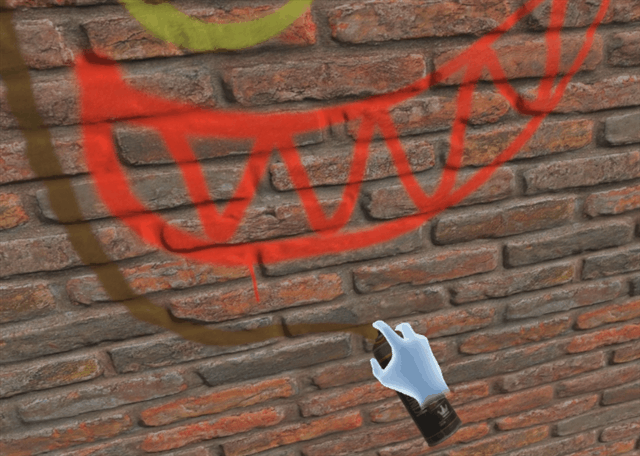
Above: Finishing a masterpiece in Kingspray Graffiti Simulator
Kingspray Graffiti Simulator is just what it sounds like — you’re given a series of walls and a huge number of spraypaint tools and set loose. Think of it as a more rambunctious but no less engrossing version of Google’s Tilt Brush art tool, which, as it happens, works just fine with the Touch through SteamVR. Oculus Medium is another nifty creation tool that’s more about sculpting than painting; I’ve yet to get my head around how it works but have already seen some people having fun with it.
Funktronic Labs’ enjoyable tower defence game Cosmic Trip is one of the few SteamVR games that completely falls apart for me when I load it up with a Rift in Steam. Happily, the Oculus Store version works fine, albeit with some funky performance issues that I don’t remember encountering when playing with a Vive. It’s still in early access, but remains a promising and engrossing experience.
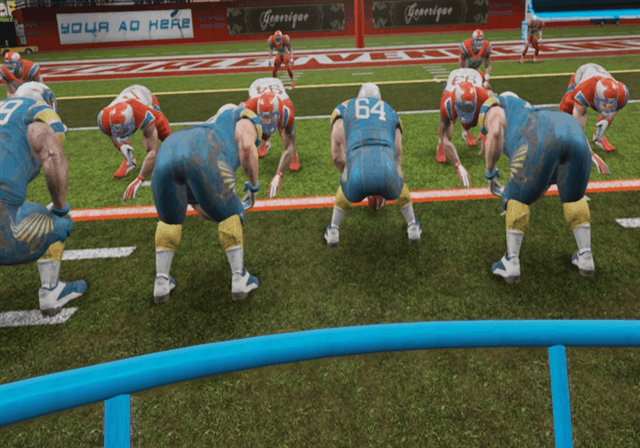
Above: A perfect pass in VR Sports Challenge
Sanzaru Games’ VR Sports Challenge lets you play a few different sports — football, basketball, hockey — in VR. I’ve been surprised at how fun and involved it is, particularly the football game. You play as the quarterback, calling plays by looking down at your wrist before hiking the ball and backing up for a pass. Let the ball fly and you’ll snap to the point-of-view of your available receiver as he makes (or blows) the catch in slow-mo.
It’s definitely got some jank around the edges, but the core of the game works surprisingly well and puts a grin on my face every time I play it. I really do feel like I’m throwing and catching a football.
Some of the launch games haven’t done as much for me. Rec Room is a cute collection of casually competitive minigames like frisbee golf and paintball, but it’s held back by poor friends-list integration and some floppy physics. Serious Sam VR feels cheap and isn’t nearly as punchy and satisfying as other VR shooters like Raw Data or Space Pirate Trainer.
Ninja Theory’s Dexed is an odd on-rails shooter that felt a little uncomfortable to play while standing up, and the lock-on aiming is floaty and imprecise.
A few of the promising games coming out on the 6th weren’t made available for us to play ahead of time, including the neat-looking zombie shooter Arizona Sunshine and the Touch-enhanced version of The Climb. Essential non-game apps like Virtual Desktop are also getting Touch support in the near future. Next year we’ll get a full release of Robo Recall along with Twisted Pixel’s noir horror game Wilson’s Heart, Ubisoft’s Star Trek: Bridge Crew, and a bunch of other unannounced or less-hyped games.
When the Rift launched back in March, it was a good headset with limited functionality and only a few good games. It was difficult to make a definitive judgment, given that Oculus was actively working on handheld controllers that would greatly expand their system’s capabilities. Now that the Touch is finally here, the Oculus Rift is complete. It was worth the wait.
Polished and carefully considered, the complete three-sensor Oculus Rift bests the competition in almost every respect. The controllers are a pleasure to use, and the headset is self-contained and comfortable. It’s got some really fun games, and between the newly expanded Oculus store and all the stuff on Steam, I feel like I’ve only scratched the surface of what there is to see and play. $US880 ($1,176) is a lot of money, and I would only recommend a complete Oculus Rift to those who have a sufficiently powerful gaming PC and really want to live on the cutting edge.
If that’s you, however, this is the way to get there.
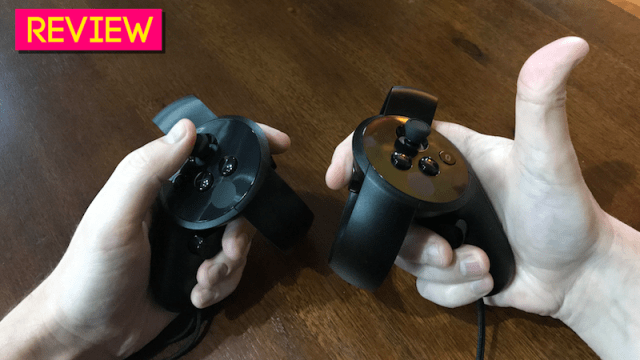
Comments
8 responses to “Oculus Touch Review: The Best VR You Can Get”
The extra sensors do come packaged with an extension cable.
Oh good, a sensible person! The number of people crying foul over the use of standard batteries has been mind-boggling.
Man I can’t wait for these. Should probably try and clear some space in the meantime so I can use ’em.
> The number of people crying foul over the use of standard batteries has been mind-boggling.
Indeed it has, I have been using rechargeables in all my devices for ages now and once the initial investment is made pays of big time in the end. The instant recharge you get by having a 2nd set of batteries is something no integrated power source can offer.
So so so true
Plus no inbuilt battery pack that’ll die in a year.
But if they used an integrated rechargeable battery, they could convince you to buy two sets of controllers (one to use, and one to charge).
Not us, but maybe those other guys apparently 😛
been a great year for VR, apart from the naysayers that spite it even tho they havnt tried it.
If you scroll past the lead image really quick. It looks like a broken Playstation controller.
I’m not sold on Gen 1 VR quite yet to jump on board, especially with the competition Microsoft’s spec promises in the new year. But at least it looks to be progressing.